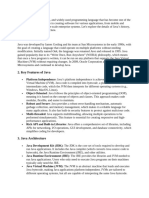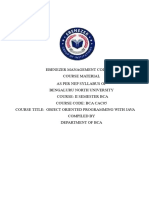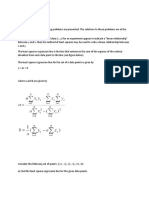Unit1 Java Notes
Uploaded by
SAKSHAM AWASthiUnit1 Java Notes
Uploaded by
SAKSHAM AWASthiUnit 1: Introduction to Java
1. Overview of Java Programming Language
Java is a high-level, object-oriented programming language developed by Sun Microsystems
(now owned by Oracle). It is platform-independent, meaning that programs written in Java
can run on any device or operating system with a Java Runtime Environment (JRE).
2. Features of Java
- Simple: Java has a syntax similar to C, making it easier for new developers to learn.
- Object-Oriented: Everything in Java is treated as an object, following the principles of
object-oriented programming.
- Platform-Independent: Java programs can run on any platform that supports Java without
modification (Write Once, Run Anywhere).
- Secure: Java has built-in security features, such as bytecode verification and runtime
security management.
- Multithreaded: Java supports multithreaded programming, allowing multiple tasks to be
performed simultaneously.
- Robust: Java has strong memory management features and built-in error-handling
mechanisms.
3. Java Development Environment: JDK, JRE, and IDEs
- JDK (Java Development Kit): A software development kit that provides all the tools
required to develop Java applications, including the JRE, compiler, debugger, and other
utilities.
- JRE (Java Runtime Environment): A runtime environment that includes the Java Virtual
Machine (JVM), core libraries, and other resources needed to run Java applications.
- IDEs (Integrated Development Environments): Software that provides tools for writing,
debugging, and testing Java programs, such as Eclipse, IntelliJ IDEA, and NetBeans.
4. Writing and Running a Java Program (Hello World Program)
A simple Java program starts with a class definition. The main method, which is the entry
point of a Java program, contains the code to be executed.
Example: public class HelloWorld {
public static void main(String[] args) {
System.out.println("Hello, World!");
}
}
5. Data Types and Variables
Java has two categories of data types: primitive types and reference types.
- Primitive types: int, float, char, boolean, etc.
- Reference types: Objects, arrays, and classes.
Variables are used to store data values. A variable must be declared with a specific data type
before it can be used.
6. Constants and Literals
- Constants: Variables whose values cannot be changed after initialization. Defined using
the final keyword.
Example: final int MAX_VALUE = 100;
- Literals: Fixed values assigned to variables, such as 10, 3.14, and "Hello".
7. Operators: Arithmetic, Relational, Logical, Bitwise
- Arithmetic Operators: +, -, *, /, % (addition, subtraction, multiplication, division, modulus)
- Relational Operators: ==, !=, >, <, >=, <= (comparison of values)
- Logical Operators: && (AND), || (OR), ! (NOT) (used for logical operations)
- Bitwise Operators: &, |, ^, ~, <<, >>, >>> (used to perform bit-level operations on integer
data types)
You might also like
- Inspection Software For Lathes: For Fanuc 0, 6, 10-15, 16, 18, 21T and It, and Yasnac LX3 ControllersNo ratings yetInspection Software For Lathes: For Fanuc 0, 6, 10-15, 16, 18, 21T and It, and Yasnac LX3 Controllers106 pages
- Java Programming for Beginners – Comprehensive NotesNo ratings yetJava Programming for Beginners – Comprehensive Notes6 pages
- Object Oriented Techniques Unit 4 & 5 By Dr. Choudhary Ravi SinghNo ratings yetObject Oriented Techniques Unit 4 & 5 By Dr. Choudhary Ravi Singh62 pages
- Java Tutorial: Why To Learn Java Programming?No ratings yetJava Tutorial: Why To Learn Java Programming?3 pages
- Java Tutorial: Why To Learn Java Programming?No ratings yetJava Tutorial: Why To Learn Java Programming?3 pages
- Java SE 8 Programmer 1 (IZO-808) Study Material PDFNo ratings yetJava SE 8 Programmer 1 (IZO-808) Study Material PDF408 pages
- Overview of Java: Dr. Turkan Ahmed KhaleelNo ratings yetOverview of Java: Dr. Turkan Ahmed Khaleel41 pages
- Java is a high-level, class-based, object-oriented programming language that was first developed by Sun Microsystems in 1991No ratings yetJava is a high-level, class-based, object-oriented programming language that was first developed by Sun Microsystems in 19919 pages
- @version 4 Study (Title "Dzonesv4", Shorttitle "Dzv4", Overlay True)No ratings yet@version 4 Study (Title "Dzonesv4", Shorttitle "Dzv4", Overlay True)6 pages
- Statistical Software Application in Economics: Chapter 1: Introduction To Softwares100% (1)Statistical Software Application in Economics: Chapter 1: Introduction To Softwares54 pages
- Blockchain Technology - The Revolution That The Digital Nepal Deserves Ijrras FinalNo ratings yetBlockchain Technology - The Revolution That The Digital Nepal Deserves Ijrras Final13 pages
- Burp Suite For Pentester - Engagement ToolsNo ratings yetBurp Suite For Pentester - Engagement Tools13 pages
- 2021 09 13 Digitronic Autogas Manual Software Multipoint Injection Systems 6.10.00.02 Ic Eng New 2No ratings yet2021 09 13 Digitronic Autogas Manual Software Multipoint Injection Systems 6.10.00.02 Ic Eng New 250 pages
- Introduction To Computing Exit Exam Model QuestionsNo ratings yetIntroduction To Computing Exit Exam Model Questions28 pages
- J2EE The Complete Reference 1st Edition Jim Keogh downloadNo ratings yetJ2EE The Complete Reference 1st Edition Jim Keogh download52 pages
- Carestream Dryview 6950 Dicom Conformance StatementNo ratings yetCarestream Dryview 6950 Dicom Conformance Statement40 pages
- End-of-Chapter Activities Guffey EBC 12e Ch03No ratings yetEnd-of-Chapter Activities Guffey EBC 12e Ch0313 pages
- IoT Based Facial Recognition Security SystemNo ratings yetIoT Based Facial Recognition Security System4 pages
- CU-2022 B.Sc. (General) Computer Science Semester-4 Paper-CC4-GE4 QPNo ratings yetCU-2022 B.Sc. (General) Computer Science Semester-4 Paper-CC4-GE4 QP2 pages
- FINAL PROJECT - PHÂN TÍCH THIẾT KẾ HỆ THỐNG THÔNG TINNo ratings yetFINAL PROJECT - PHÂN TÍCH THIẾT KẾ HỆ THỐNG THÔNG TIN47 pages

























































































